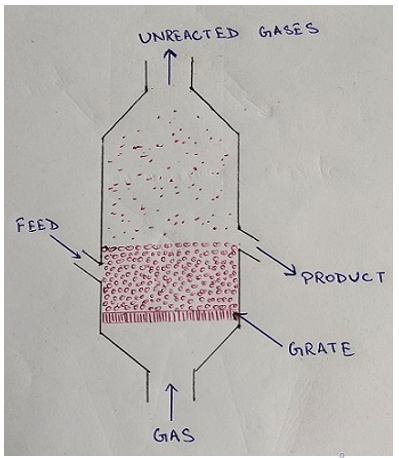This set of Extractive Metallurgy Multiple Choice Questions & Answers (MCQs) focuses on “Calcination and Roasting – Set 2”.
1. What should be the physical condition of the product, if we have to perform the smelting process of an ore in a blast furnace?
a) Insoluble compounds
b) Fine
c) Porous
d) Coarse and cellular
View Answer
Explanation: The product used for the smelting process of an ore in a blast furnace should be coarse and cellular. The product should be fine for a retort and porous if we are doing leaching.
2. What is the basic principle of a metallurgical roaster?
a) The flow of the mixture of solid ore
b) Countercurrent flow of solid ore and liquid
c) Countercurrent flow of solid ore and oxidizing agents
d) Countercurrent flow of solid ore and reducing agents
View Answer
Explanation: The basic principle of almost every metallurgical roaster is countercurrent flow of solid ore and oxidizing gases. As the world is developing the design of roasters are changing but the basic principle remains the same.
3. What is the direction of the flow of ore and gases respectively in Multiple Hearth Roasting?
a) Downwards and upwards
b) Upwards and downwards
c) Leftwards and Rightwards
d) Rightwards and leftwards
View Answer
Explanation: In Multiple Hearth Roasting, the ore is discharged at the top hearth which gradually moves downwards through various hearths and emerges at the bottom. The oxidizing gases flow upwards.
4. What is the drawback of Multiple Hearth roasting?
a) The roasting process is very fast
b) The roasting process is slow
c) Evolved gases contain SO2
d) Oxidizing gases are used
View Answer
Explanation: A drawback of Multiple Hearth Roasting is that the roasting process is slow. The other drawback is that when the sulphurous gases are evolved after sulphide roasting, it is not suitable for the production of sulphuric acid.
5. The type of roasting in which preheated ore particles are made to fall with hot air in a large combustion chamber is called ______
a) Fluidized Bed roasting
b) Multiple Hearth roasting
c) Sinter roasting
d) Flash roasting
View Answer
Explanation: In flash roasting, ore particles which are preheated are put in a large combustion chamber with hot air. The result of this is instantaneous oxidation of the combustible particles of the ore takes place.
6. What is the advantage of using Fluidized Bed Roaster?
a) It is very energy consuming
b) It cannot be used for recovery of Sulphur
c) It is very energy efficient
d) It is not operated in a vacuum
View Answer
Explanation: The main advantage of using Fluidized Bed Roaster is that it is very energy efficient because it is operated independently. The other advantage is that is can be used to recover Sulphur because of the presence of SO2 in the gas produced.
7. In which type of Roasting operation does the roasting and agglomeration processes take place simultaneously?
a) Sinter Roasting
b) Flash Roasting
c) Fluidized Bed Roasting
d) Multiple Hearth Roasting
View Answer
Explanation: Whenever we use fine ores, we have to go through the agglomeration process before it can be used for any furnace. So, Sinter Roasting is a process in which we do both the roasting and agglomeration process simultaneously. Sintering is an agglomeration technique.
8. What do we call the product after the agglomeration process, which can be used as a blast in a blast furnace?
a) Agglomerate
b) Blaster
c) Sinter
d) Pallets
View Answer
Explanation: Sinter is the final product after an agglomeration process. It is porous and looks like igneous rock. They are made porous to trap moisture.
9. What type of reactor has been shown below?

a) Rotary Kiln
b) Fluidized Bed Reactor
c) Fixed Bed Reactor
d) Retort
View Answer
Explanation: In Fluidized Bed Reactor the ore is roasted in an upstream of gases or air. The unreacted gases flow out from the top of the surface and after roasting product is collected as shown in the figure.
Sanfoundry Global Education & Learning Series – Extractive Metallurgy.
To practice all areas of Extractive Metallurgy, here is complete set of Multiple Choice Questions and Answers.
If you find a mistake in question / option / answer, kindly take a screenshot and email to [email protected]
